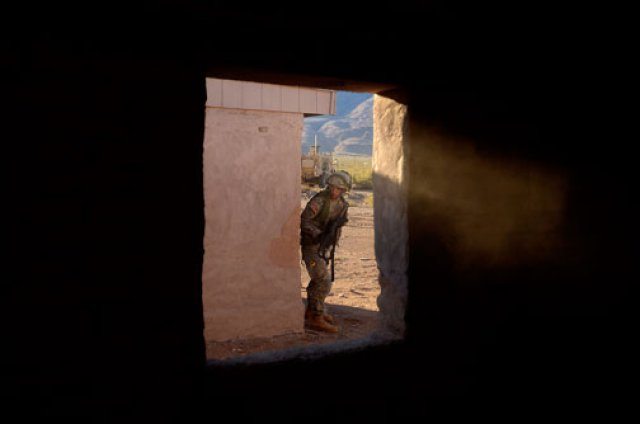In the American Old West, some 130 years ago, a horseback-riding U.S. Army cavalry scout would cross a seemingly endless desert to relay hand-written battlefield information to his commander, with nothing more than a compass and map to guide him.
Fast forward to 2011: Soldiers of the 2nd Brigade Combat Team, 1st Armored Division, from Fort Bliss, Texas, stood in the vast wilderness of White Sands Missile Range, N.M., equipped with the latest forms of ruggedized communications technology, and in seconds shared critical battlefield information with commanders and dozens of others, located miles away across the desert.
For three weeks in November, the brigade sent approximately 3,800 Soldiers and 1,000 vehicles 45 miles northward into the New Mexico wilderness, to test and evaluate dozens of computerized, digital systems that could give the Army a future tactical edge, during an exercise called the Network Integration Evaluation 12.1, the second in a series of semi-annual evaluations designed to integrate and mature the Army’s tactical network.
Brigade Commander Col. Daniel A. Pinnell said all of the approximately 45 systems under evaluation are potentially feasible, but that he is looking for candid feedback from his Soldiers — nearly half of who are seasoned combat veterans — to help the Army make smart decisions on which systems are most viable. For his Soldiers to be tasked to see if these new systems work is “pretty cool,” he said.
“New technology such as this helps our communications and situational awareness for all our Soldiers on the battlefield,” said Pfc. Dustin A. Belshe, a cavalry scout with A Troop, 1st Squadron, 1st Cavalry Regiment, a subordinate unit within the brigade. This technology can help the Army from losing Soldiers and provide better communication between higher ups and the Soldiers on the ground.”
The NIE 12.1 priorities included working to extend the network to the individual Soldier on the battlefield, advancing mission command on the move and continuing to establish the integrated network baseline, Army officials said.
Soldiers here put their hands on the new forms of technology, learned how the systems work and replicated battlefield circumstances to determine how the systems would perform. From handheld devices that display detailed maps showing locations of individual Soldiers and buildings, to mine-resistant, ambush-protected vehicles, known as MRAPS, equipped with mobile, secure “hot spot”-type transmitter/receivers that reach individual Soldiers scattered in the field, to Rifleman Radios that incorporate radio to radio to radio relay capabilities that greatly extend the range of hand-held radios, the hardware and supporting software tested here are cutting edge.
“Most of the technology is ahead of its time. As scientists and engineers develop these ideas, the Army tasks us to use our training and experience to see if it is useful in a realistic environment,” explained 1st Lt. Eric V. Muirhead, executive officer of B Troop, 1st Sqdn., 1st Cav. Regt. “If we think this equipment has potential, it moves on toward full adoption, but if we don’t think it is worth it, the Army passes. This is both to save money, but more importantly, lives.”
“It’s an excellent opportunity for my Soldiers, and they take a lot of pride in what they’re doing here and take it very seriously,” said Pinnell.
Gazing upon a hand-sized computer screen with nothing but desert and mountains as backdrops, and a layer of dust visible on the screen, 2nd Lt. Adam E. Martin can share precise battlefield information with distant Soldiers and his chain of command the moment his team encounters an “enemy.”
“My role in this exercise is to test out a new system called Nett Warrior. It’s a specialized Android phone meant to help with situational awareness, planning processes, reporting enemy information and assisting with executing missions,” said Martin, a platoon leader with B Troop, 1st Sqdn., 1st Cav. Regt.
Just as in the harsh, mountainous, desert conditions found in Afghanistan, radio transmissions at White Sands can be difficult. The Soldiers conducted field operations and entered military operations in urban terrain sites, equipped with systems that nearly no one in the Army has seen, and subjected the hardware to the rigorous motions.
“Our primary focus right now is what the Army calls ‘the network,'” said Muirhead. “Our goal is to develop systems that cut through the fog of war and give everyone, from privates to generals, access to rapid and accurate information and communication. The network has the potential to make even the single rifleman a major player on the 21st century battlefield, allowing him to communicate to all levels, control unmanned drones and sensors, and even call for indirect fire or medevac at the touch of a button.”
While the brigade Soldiers put the new equipment through its paces, stopping just short of smashing the technology into pieces on the ground, they reported both positive and negative experiences.
“The way I am interacting with the technology is incorporating it in the different missions we conduct daily,” said Martin. “It can be frustrating at times because of technological hiccups. During missions, if the systems fail, it can cause the Soldiers to not want to use it, but this is all a part of our evaluation.”
“The new technology can help down the road,” added Spc. Colleen E. Pellish, a unit supply specialist with Forward Support Company, 1st Battalion, 35th Armor Regiment. “Testing it now and knowing the pros and cons can help to make the technology better for use in the future, or (lead us to) try something else.”
Spc. Scott R. Vitale, a mortarman with 1st Bn., 35th Armor Regt., agreed. “It’s nice to know that we help our brothers and sisters in theater by helping fine tune the new and upcoming technology.”
Michael Tolzmann works for the Joint Hometown News Service at Fort Meade, Md.











